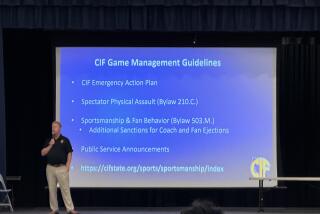In Fairness to Student-Athletes, No-Fail Rule Gets Failing Grade
- Share via
When the El Camino Real High football team began postseason play Friday night, linebacker Scott Hanson was not in uniform.
He had been ruled academically ineligible.
Just another dumb jock?
Not unless you consider three A’s, a B and a 3.1 grade point average the work of a dumb jock.
And Hanson wasn’t exactly cruising through school on a diet of basket-weaving and remedial aerobics classes. His A’s came in government and computer programming classes and in his role as a teaching assistant. His B came in advanced composition.
His F came in calculus.
Under the rules of the Los Angeles Board of Education, that makes Hanson ineligible for the postseason playoffs. The C-average/no-fail rule, passed in 1982, requires at least a C average and no failing grades in any class for a student to take part in extracurricular activities.
There should be little or no argument over the first requirement of the rule. If a student cannot maintain a C average, then he doesn’t belong on the athletic field, or in the band, or in the school play. He belongs in the library or with a tutor.
The position of Dick Crowell, boys basketball coach at San Fernando High School, just doesn’t cut it.
“In all the discussions and comments concerning this issue,” Crowell wrote in a letter to The Times, “I have yet to come across this point of view: Why should it be more difficult to play ball than to earn a high school diploma? Doesn’t the public realize that a student with a 1.0 grade point average and 170 credits earns a diploma?”
But what else?
What chance does he have to go on to college? With a D average, how much has he learned that will prepare him to go out into the working world?
Of course, there is always a career in athletics. But not for many.
Consider all the kids playing football at all the high schools across the country. Then consider that there are little more than 1,100 roster positions available in the National Football League. There are only about 275 spots in the National Basketball Assn. Only a very small percentage of all the high school athletes are ever going to be able to make a living out of their talent.
One Valley high school basketball star bragged when he got to junior college that he didn’t have to study, that when he got to the NBA, he would hire somebody to help him with any mathematical problems he might run into.
Several weeks after making that statement, his grades caught up with him. He left the school and isn’t likely to resurface in the NBA.
Said Cleveland High football Coach Steve Landress of Rita Walters, the school board member who authored the C-average/no-fail rule: “The lady wrote the rule because she didn’t want dumb jocks. As a result, you don’t have dumb jocks walking around, you have dumb street gang members walking around.”
What seems lost on Landress is that these kids must be made to take advantage of this period when they are off the streets and in the classroom. If not, they will play their three years of athletics and then be back walking the streets as dumb, unemployed welfare recipients.
And what will they have gained in school? They may have won the high hurdles, but be totally unable to take on life’s big hurdles.
Kids who are bused into the San Fernando Valley from the inner city become heroes and role models for their ability to turn a meaningless life on the streets into a worthwhile life on the athletic field.
But, if a few years later, they are back on the streets, without a job, what kind of motivation does that give to those following them?
The no-fail portion of the board’s rule, however, is something else. Just because a student fails calculus, it doesn’t mean he is not going to college or not going to be able to function in life.
If that were true, an awful lot of us would be in trouble.
A student should not be penalized for taking more difficult courses, for attempting to stretch his mind even further than required by high school administrators.
Walters argues that without the no-fail rule, students can maintain a C average by balancing the tough academic courses they may be failing with easy classes, like physical education or work services.
The solution?
I think they’ve found it in the Moorpark Union High School District.
Students there are required to maintain a C average to stay eligible for extracurricular activities. They become ineligible if they receive an F in English, math, history or biology--the four courses required for graduation.
That seems a fair compromise.
Let’s make sure the students are doing average work in a course that will lead them to graduation, and hopefully to college.
But let’s not penalize them for trying to do more.
More to Read
Get our high school sports newsletter
Prep Rally is devoted to the SoCal high school sports experience, bringing you scores, stories and a behind-the-scenes look at what makes prep sports so popular.
You may occasionally receive promotional content from the Los Angeles Times.






